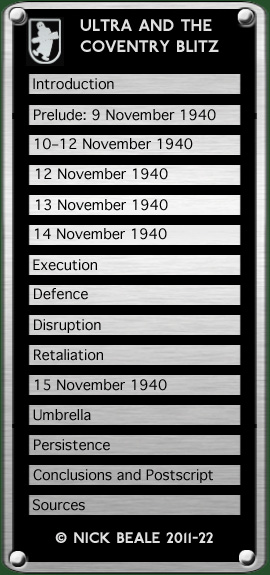|
Air Commodore A.R. Boyle, Director of Intelligence, wrote a report for Sholto Douglas on Moonlight Sonata and how the RAF should respond, both defensively and offensively. Probst had by now elaborated that the big operations would in fact take place over three successive nights and by 19.00 hours BST had revealed that there would be a code word for each day or phase of the attack: Day 1 Regenschirm (Umbrella) Day 2 Mondschein Serenade [sic] (Moonshine Serenade) Day 3 [not known] Sholto Douglas noted: I really can’t believe that this is a three night show. I believe there are 3 phases. ‘Umbrella’ is K.G. 100. ‘Moonshine Serenade’. No. 3 phase is something else. How can even the optimistic Boche hope to get 3 successive nights of fine weather[?]
Meanwhile Ultra had gone silent, with Bletchley temporarily unable to break Luftwaffe keys including “Brown” used by KGr. 100 and the beam stations. A report was issued at 01.15 hrs. on the 13th but it was over 48 hours before the next, at 02.40 on the 15th (two more reports would follow that day, at 14.50 and 17.15 hours—suggesting that there had been a breakthrough and a backlog was being cleared). In 1940 Peter Gray Lucas of the Air Ministry was working at the Cheadle Y-Service Station, on low-grade Luftwaffe tactical signals. In 1993 he wrote that: A harbour defence command in Antwerp regularly received notice of ‘own’ aircraft about to fly over. On the afternoon of 14 November 1940 the signal read ‘ANGRIFF [attack] KORN’, but the [human] computors could not guess at the time and did not guess until later that KORN was the code-word for Coventry.
Weather will be mainly fine in the Midlands and southern England but elsewhere there will be occasional showers of rain or hail … Air Ministry forecast at 07.00 hours GMT Decrypts had dried up but in a sense their contribution had already been made. The Y-Service intercepted KGr. 100’s “D3R” signal at the time and frequency promised by Ultra and direction-finding showed that it emanated from Vannes. So Moonlight Sonata was on, a day sooner than the British expected—the moon would not be full until the night of the 15th. In a handwritten note to DHO, A/C Boyle agreed that the attack would probably involve three waves rather than three nights. The prisoner (i.e. Probst) thought 500–800 aircraft would take part and had mentioned “the industrial district” of England. Boyle ended by saying, “I am trying to get more information.” A briefing note was prepared for Prime Minister Churchill which, according to his Private Secretary, he read that afternoon in his car, en route from London to rural Oxfordshire. This note set out the four expected target areas in the south east, adding that they might be alternatives depending on local weather conditions. It was thought that the operation would come between the 15th and 20th, that Göring would coordinate the attack and that the whole German bomber force would be involved, perhaps in retaliation for a recent raid on Munich (a conjecture later confirmed by an OKW communiqué). The fourth paragraph summarised what Probst had said about fomenting revolution in the West Midlands, while the next added a note of caution: We believe that the target will be one of those [four] noted … above, probably in the vicinity of London, but if further information indicates Coventry, Birmingham or elsewhere, we hope to get instructions out in time. The paper also gave a brief resumé of the Cold Water plan (the orders for which had been given at 03.00 that day). What it emphatically did not say was that the raid was due that very night or that Coventry was the target. Nevertheless, the city’s defences had been reinforced. In a note to Douglas the day after the raid, Stevenson wrote that: (a) the circus of 12 Bofors arrived in Coventry on 12th Nov. (b) The 16 balloons (2 flights) should have arrived yesterday. We can assume their presence but this cannot be confirmed as the teleprint lines are down. (c) We had to add an extra flight to a fighter squadron based in defence of Coventry. 306 Polish Squadron has had this flight added and it has been moved to Ternhill [in Shropshire]. (d) The factories are being linked to the local Observer Corps centres to give “Jim Crow” warning of hostile a/c approach. (e) There was no addition in terms of guns. There are 40 HAA [heavy anti-aircraft] in Coventry. continued on next page …
|
|||||||


 He nevertheless gave Cold Water his approval, noting that other members of the Air Staff were keen to see KGr. 100’s base at Vannes attacked and that the “special Whitleys for detecting river beams” should attack the Cherbourg transmitters. Arrangements were duly set in train so that the plan could be activated as soon as the tell-tale signal was heard. All that would be required would be the signal from the Air Ministry “Executive Cold Water.”
He nevertheless gave Cold Water his approval, noting that other members of the Air Staff were keen to see KGr. 100’s base at Vannes attacked and that the “special Whitleys for detecting river beams” should attack the Cherbourg transmitters. Arrangements were duly set in train so that the plan could be activated as soon as the tell-tale signal was heard. All that would be required would be the signal from the Air Ministry “Executive Cold Water.”